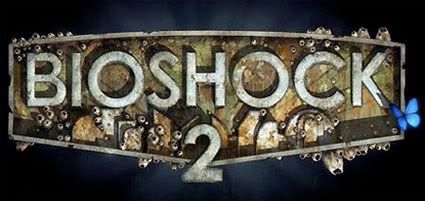
“Somewhere… beyond the sea, somewhere… waiting for me…”
I mentioned in my review of the first BioShock that Rapture is a living, breathing entity. One of the biggest impressions made by its sequel is that the underwater city didn’t just up and disappear after the conclusion of the first game. Rapture marched on without us, and when we return to it, the city is both instantly recognizable and possessed with the feeling that something has gone horribly, horribly wrong.
…Okay, Rapture wasn’t that great a place to live to begin with, at least when we’re first introduced to it. But whereas in the first game the Splicers felt like a disorganized and individualistic mob of gibbering pseudo-zombies driven mad by their psychic powers, here they have been given purpose, direction and even promises of redemption. There are still forces struggling to control Rapture and maintain the flow of the precious material known as ADAM that functions as the life-blood of the city.
Into this volatile mix of elements comes Subject Delta, a prototype Big Daddy awakened from hibernation. Unlike the other not-so-gentle giants, Delta can use plasmids and shares a bond with a particular Little Sister. Like Jack, the protagonist of the first game, we as Delta are presented with both overarching obstacles to overcome and the means, through our choices and actions (or inactions), to change Rapture forever.
Since the introduction of Something in the Sea, I was looking forward to this release. The first game did a fantastic job building atmosphere, telling a story and actually having underlying themes and concepts that extended the game beyond yet another exercise in shooting bullets at things until they fall down. So how did the sequel fare?
Stuff I Didn’t Like
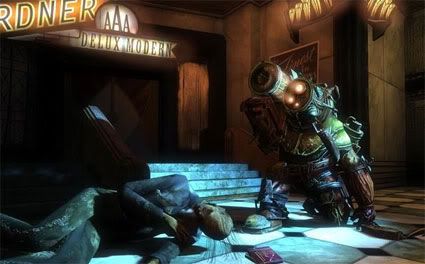
“What’s that? There’s a lack of innovation? NOOOOOOOO!“
BioShock, for all of its echoes of, callbacks to and inspiration from System Shock 2, broke new ground in the realm of console shooters. Its narrative complexity, philosophical grounding and unique aesthetic set it head and shoulders above others in the genre, most of whom are trying to capture the money-making magic of Halo. BioShock 2 feels much less innovative. While there isn’t anything wrong with taking what worked in a successful title and attempting to improve it, the feeling that we’ve been here before can water the enthusiasm of the player somewhat. The first half of the game, beyond the novelty of Delta’s abilities as a Big Daddy, feel awfully similar to most of the preceding title. There’s something about the story’s structure and pacing that feels somewhat “safe”, at least at first. It’s difficult for me to fully articulate why this bothered me. Reinventing the wheel isn’t necessary when making a sequel, after all.
Anyway, the only thing persistent from the first game that really continued to bug me as I played was the knowledge that what Yahtzee calls “that side-tracking shit” was going to get pulled on me any time the objective at hand seemed simple to complete. In fact, my wife and I both quoted the Zero Punctuation review of BioShock many, many times as I played through. The main antagonist in BioShock 2 is female which makes it feel even more like she’s SHODAN with skin on. Again, this is a minor complaint, and to be honest it’s really the only complaint I can make.
Stuff About Which I’m Ambivalent
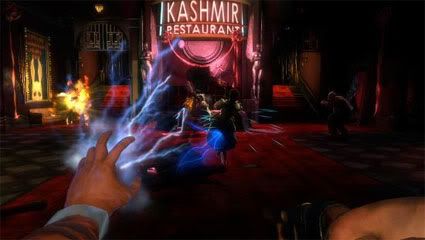
A new section in my reviews. Shocking, no?
So I dove into the multiplayer that I spent some time saying we didn’t need and I’m ambivalent about it. I don’t love it but I’m also a bit surprised in that I don’t loathe it. As much as I appreciate its attempt to mix up the online shooter formula with trials, unlockable loadouts & items and something that vaguely resembles a story available through your apartments’ radio announcements and audio logs, it’s still an online shooter. There’s some fun to be had as you combine plasmids with firearms and especially when you stumble across a Big Daddy suit, but I stand by my initial feeling that it’s a little tacked on.
Stuff I Liked
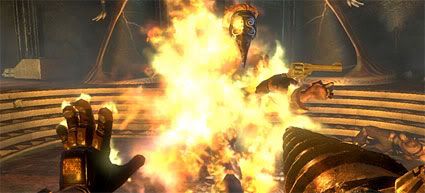
Gives new meaning to the phrase “Drill, baby, drill.”
First of all, you’re a Big Daddy. You’re a towering, ponderous, super-strong giant in an armored diving suit and your melee weapon of choice is a huge drill. There’s nothing about this concept I don’t like. Now, if you’ll recall, in the first BioShock Big Daddies can be taken down by either our silent protagonist or a mob of Splicers. What differentiates you from those other unfortunate Big Daddies is the fact you have (at least I’m hoping) a functional frontal lobe. Tactics actually come into play in this game beyond “chase down the bad guys and set them on fire”, which is something I’ll discuss in the next section.
The slight changes to the weapons loadout work well. Having the drill & rivet gun definitely add to the “You’re a Big Daddy now” feeling, and wielding a double-barreled shotgun made me wonder how Bruce Campbell would fare in this situation. A chainsaw isn’t that far removed from a drill, after all. Anyway, there’s also the fact that you can use your plasmids at the same time as your other weapons, which not only saves time in switching from one to the other but also allows for some of that creative thinking stuff. The game actually rewards you for being creative and switching things up with the research bonuses.
While the voice-acting isn’t quite as immersive as that of the first BioShock, it’s still quite good, especially when it comes to the characters of Eleanor and Alex. I’ll stop my train of thought at that station because I don’t want to spoil it for you. Finally, the plumbing system from the first game is replaced with a much more straightforward mini-game for hacking. Unlike the replacement systems for decryption and bypasses in Mass Effect 2, it’s far less tedious and a bit more challenging to hack something, and it’s quite rewarding when you pull a hack off while under enemy fire.
Stuff I Loved
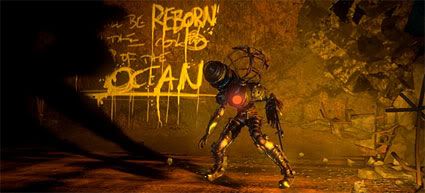
…Oh God.
“You might stop fearing death,” said a member of TV Tropes about the games Vita-Chambers, “but that doesn’t stop you from being afraid.” No character drives this point home more than the Big Sisters. Originally planned to be a single recurring villain, the Big Sister is an extremely elite sort of antagonistic creature that really, really doesn’t like you messing with her pint-sized dress-wearing barefoot counterparts. Unlike the huge and often passive Big Daddies, Big Sisters actively seek you out, chasing you through Rapture and using combinations of lithe acrobatics, highly evolved plasmids and a wicked sword-like ADAM extraction needle to encourage you to stop. The knowledge that you can pop out of a Vita-Chamber nearby after she hands you a severe ass-kicking never stops the blood-curdling screech they emit as they track you down from being terrifying.
The game tells you to “Prepare yourself” when the Big Sister is coming for you. Thankfully you can channel your fear into those preparations by laying traps, hacking security systems and loading up on more effective ammunition. BioShock 2 rewards creative thinking, as I’ve said, and this includes setting up some very nasty surprises for enemies coming your way. Both when dealing with a Big Sister and watching over an adopted Little Sister as she gathers ADAM from a corpse, the best way to ensure your survival and conserve your resources is to examine the area, plot out possible routes of approach and trap them accordingly. The dead strewn about Rapture lets you pick and choose where your gathering operations take place, and on more than one occasion I’d come into a room with a vent and smile, because I knew exactly where I’d be meeting the Big Sister. This didn’t make the experience of fighting them less harrowing, for me, and I played on Normal difficulty. I suspect future playthroughs will have me cursing more and voiding myself less when the screaming Big Sister comes at me out of a haze of fire and terror.
This brings me to the Little Sisters.
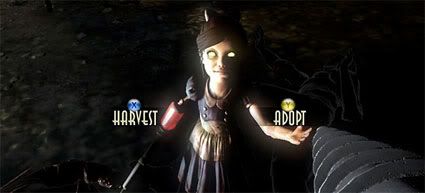
Maybe my paternal instincts kick in hardcore when I see one. Maybe the team at 2K have really made them more sympathetic over the years. Maybe I’m just a pussy. However, when the Little Sister looks up from the broken body of “Mr. Bubbles” only to smile brightly at you, and in some cases hop up and down excitedly (“Are we going to be together now, Daddy?”), there’s no way in hell I can bring myself to tear them apart for the sake of holding a flailing sea slug in my hand. And killing Little Sisters, besides guaranteeing one of the games ‘bad’ endings, would deprive you of some very funny and rather heartwarming lines of dialog.
For example, carry a Little Sister on your shoulders, then zap a Splicer with the Electro Bolt plasmid and/or pelt them with bullets from the machine gun. “Look, Daddy!” the Little Sister cries with glee. “He’s dancing!” And if you’re in the middle of a gathering operation, and one of the Splicers gets to your Little Sister, rush over with your drill in full spin. As you reduce the would-be pederast to little bloody chunks, the Little Sister proclaims “Nobody messes with my daddy!” Finally, there’s the “Daddy? You always save me from the monsters” line when you pick her up after a harrowing battle, and the very soft and heart-felt “Thank you” spoken to you after some of them crawl into their vents after being rescued.
Again, maybe it’s just me. Maybe you’ll go into this game with the intent to rip every single one of these toddling terrors to shreds. That’s your call. For me, protecting and rescuing the Little Sisters added depth to the game and really pulled me into the experience. We learn a lot more about them, what they go through in the rather horrific process that creates them and how they see Rapture. Especially after those experiences, harvesting them for their parasites rather than setting them free seems as cruel an act as anything perpetuated by the game’s villains.
BioShock 2 isn’t just BioShock with a fresh coat of paint and a few cool new weapons. It’s not entirely different, either, and if you haven’t played the first game you might feel a bit lost, confused or even disinterested. Fans of the first game are in for a treat, and while it doesn’t really push the envelope in any way, it does what the first game did very well and, in some cases, better. In a world where sequels are often an ever-extending litany of disappointments in light of the original title, BioShock 2 does what good sequels always should.
Bottom Line: You may want to play the first game before picking this one up. But even if you don’t, in my opinion, it’s worth your time, it’s fun to play and it still tells a good story that has something going on besides loud gunplay and teabagging. Buy it.



February 20, 2010 at 3:28 pm
Incidentally, I can no longer listen to the song “Beyond the Sea,” without becoming nervous. (Thank so much, 2K Marketing Dept.!)